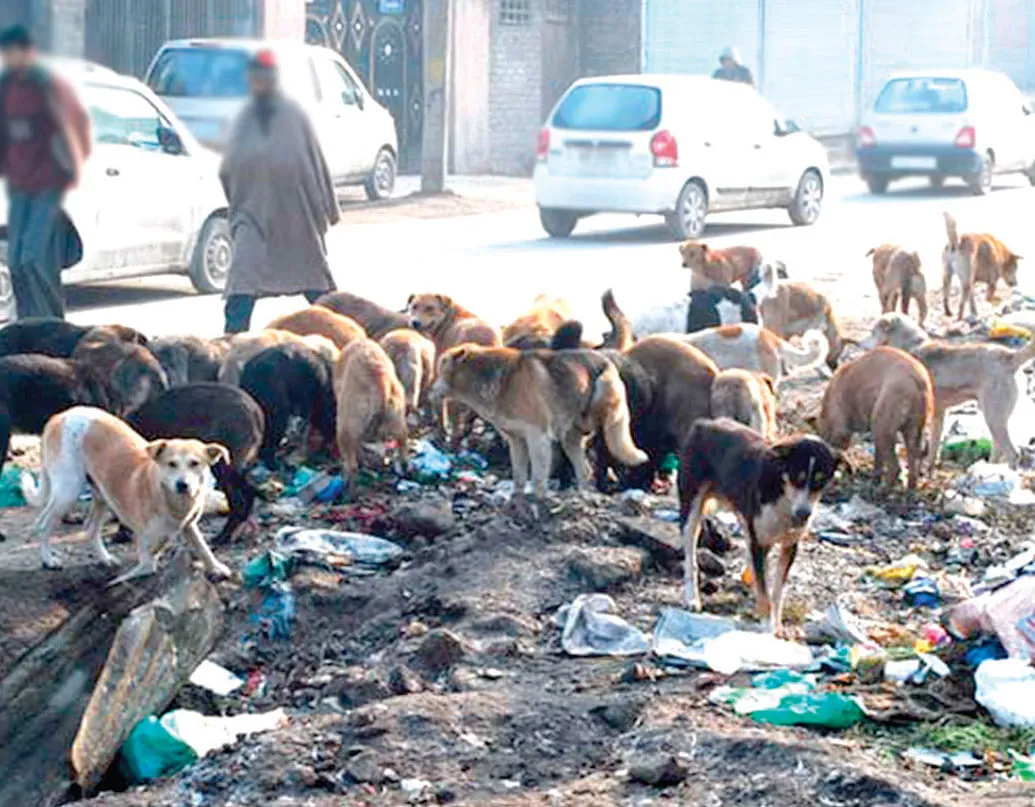Dog menace is one of the biggest threats to people of the valley. There are frequent reports of dog bites from different corners of valley. Stray dogs also play a significant role in transmission of many zoonotic diseases, especially rabies.
One of the main reasons for the increase in stray dog numbers is the careless poultry waste disposal. The dogs display a tendency to selectively feed on protein-rich sources of food through scavenging, compensating for the lack of hunting for meat.
That is why dozens of stray dogs naturally get attracted to the by products thrown in front of poultry retailers and dumping yards. These by products not only increases stray dog population but also wastage of huge amount of protein and fats which can be utilised as raw material for production of different value added products.
These by products not only attract stray dogs but enhance their breeding efficiency also. Stray dogs are always found where there are chances for them to get food.
In order to manage dog populations on streets, it is essential to manage garbage especially poultry wastes and ensure that there are no open bins and garbage dumps within city.
Sterilisation of dogs is not the only option to control dog menace in Srinagar city and other towns. Animal waste management is also as important. In my opinion both solutions are having equal value for dog population control. Rather contribution of efficient animal by product utilisation would have been of much greater role.
Efficient utilisation of by-products has direct impact on the economy and environmental pollution also. Non-utilisation or under-utilisation of by-products not only lead to loss of potential revenues but also lead to the added and increasing cost of disposal of these products.
Non-utilisation of animal by-products in a proper way may create major aesthetic and catastrophic health problem.
Besides pollution and hazard aspects, in many cases meat and poultry waste have a potential for recycling raw materials or for conversion into useful products of higher value. Waste products from the poultry slaughtering must be efficiently dealt with as the growth of these industries depends largely on waste management.
It’s easy to start rendering when by products are generated at few locations ( slaughter houses). But Kashmir valley consumers mostly prefer live and fresh chicken butchered before their eyes, which results in most of chickens being slaughtered by the retailers in a very unhygienic manner.
Traditional poultry dressing facilities at the wholesale or retail level are completely manual, with no sanitary measures taken for the dressing floor. As a result, hygienic slaughtering and proper utilisation of by-products are currently the most important issues in the poultry industry of valley.
By products from poultry slaughtering in cities and towns can be value added by an important process called rendering. Rendering is a process that changes animal waste tissue into useable, valuable materials. Materials like chicken waste, tissues, and feathers are converted into high protein meal like meat cum bone meal and feather meal.
Rendering can be carried out on chicken by products produced during dressing of chicken. The nutrient content of a meal can vary, and depends on the type of processed raw material.
A poultry meal is a high-quality feed material that contains fatty acids, amino acids, minerals, and oils. The end product formed after rendering of byproducts is important ingredient in poultry feed formulation thus can open new window in Poultry industry of valley.
In rendering process poultry leftovers ( feathers, skin, shanks and intestine ) are cooked, sterilized, and dried to 8% of moisture. Fat extraction level is recommended at yields between 10% to 12%. Draining and pressing are applied for the separation of the melted oil from the solid proteins. Oil can be clarified by settling or decanting.
Dried poultry by-products are ground into a powder, creating poultry meat meal, feather meal, and blood meal. Meat cum bone meal is an excellent source of supplemental protein for poultry feed manufacturing and has a well-balanced amino acid profile. Digestibility of the protein fraction is normally quite high, ranging from 81 to 87% .
It is well suited for use in feeding monogastric and provides not only a well-balanced protein source, but also a highly available source of calcium and phosphorus.
The end product which is called meat cum bone meal is a powerful addition to animal nutrition and a cheap source of protein. It can be used for feed manufacturing of chickens.
It is very important when the animals are not fed by additional vitamins and minerals. Meat cum bone meal is very popular in poultry feed manufacturing because the low prices of meal allow improving animal nutrition without much effort. Poultry meal contains phosphorus and calcium, which are difficult to obtain.
Converting poultry and other meat by-products into feed, is a good way to solve the environmental problems caused by animal waste. Animal by-products can be dangerous for environment If not properly managed; they can cause air pollution and water contamination by bacteria and viruses.
Municipal authorities of valley have to play great role in management of poultry by- products through establishment of rendering plants at different locations of valley.
There is need to educate people for this type of poultry and meat waste management. Regarding collection of poultry by products like skin, features, poultry head and shanks, we need to keep separate vehicles for this purpose.
And to encourage this type of collection monthly incentives can be given to poultry retailers on the basis of weight of by-products handed over to municipality authorities on daily basis.
Dr Mukhtar Ahmad is a Field Veterinarian.
Disclaimer: The views and opinions expressed in this article are the personal opinions of the author.
The facts, analysis, assumptions and perspective appearing in the article do not reflect the views of GK.






